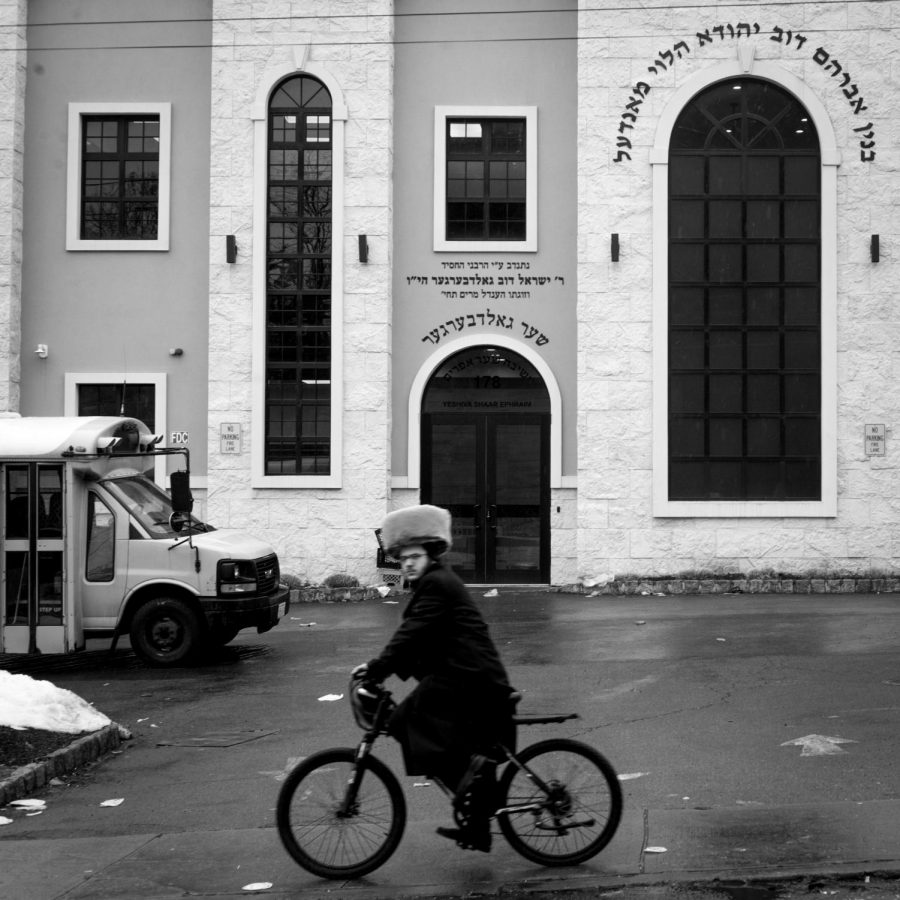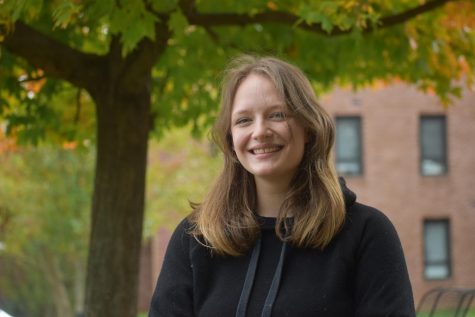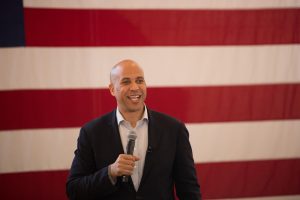Ramapo election aims to restore equity in education
A Jewish Orthodox man drives a bicycle through Monsey, a town in Rockland County, N.Y.
March 8, 2021
Juniors Clara Kolker and Clyde Lederman spoke to the Upper School during a recent morning meeting about a special election being held for the school board in the East Ramapo Central School District (ERCSD). Kolker and Lederman had been phone banking for a coalition of Black women running for school board – calling constituents and raising awareness about the election and its importance – and invited other students to do the same. This election held the power to completely change the futures of nearly 9,000 public school students.
The election, which took place on Feb. 2, was a pivotal one. Following a lawsuit won by the Spring Valley National Association for the Advanced of Colored People (NAACP) and the New York Civil Liberties Union (NYCLU) against the district, a federal court ruled that the way school board elections were conducted violated the Voting Rights Act and unfairly disenfranchised voters of color.
Last summer, Judge Cathy Seibel found that the at-large voting process violated the voting rights of Black and Latino public school parents. No matter what, the private school community would always outvote the public school community. She added that the voting was inherently racially discriminatory.
“In the district, policies benefiting private schools or reducing expenditures on public education benefit the white community, and policies benefiting public schools or reducing expenditures on private education benefit the Black and Latino communities,” she wrote.
Previously, the election was conducted at large, so all of the residents of the county would vote for all of the board seats. Now the district has been divided into nine wards, and residents can only vote for representatives of their ward, similar to congressional districts. Previously, Black and Latino voters were continually outvoted by the Orthodox community; with the ward system, voting blocs become less powerful.
Incumbents Ashley Leveille, Sabrina Charles-Pierre, Yehuda Weissmandl, Harry Grossman, Mark Berkowitz, and Ephraim Weissmandl won their elections. In Ward 3, which had no previous incumbent, Sherry McGill, a teacher and parent in the ERCSD, was elected. In Ward 4, Shimon Rose won. In Ward 5, Yossi Weiss won.
Leveile, Charles-Pierre, and McGill are all representatives of the public school community, while the remainder are from the Hasidic community, whose children attend yeshivas – private Jewish schools.
Lederman believes the election was a victory for the public school community. “The political system hadn’t been working and something else was needed. Judge Seibel said this in her decision as well: this may not change the control of the board, but it will bring it into compliance where it’s no longer discriminatory and improper,” he said.
The lawsuit and special election was partially in reaction to over a decade of funding cuts to public education in ERCSD, and the redistribution of funds to private religious schools. However, it may be more complicated than that. As Kolker put it, “What could be considered a pretty banal story about allocation of funds, which is already in itself very important because it has tangible effects, there is that undercurrent of cultural tensions and ethnic tensions.”
Beginning in 2009, the Ramapo school board began making spending cuts to the public schools to make up for a budget crisis. By 2014, over 450 teachers had been fired, including all social workers and 15 special education teachers, according to a report by New York State Education Department (NYSED).
These decisions were largely made by people who did not themselves stand to suffer from severe budget cuts to the public schools. Rockland County, where East Ramapo is located, has one of the largest Jewish populations in the country. In East Ramapo, the majority of the 24,000 private school students attend yeshivas. On the other hand, only 9,000 students attend the public schools.
Since 2005, the Ramapo school board has been composed of primarily Orthodox Jewish men, whose families don’t attend the public schools. In 2014, seven out of nine board members represented the private school community. Since then, the number has shifted to six out of nine.
Additional spending cuts included reducing kindergarten to a half day, cutting sports by 50 percent, and freezing purchases on supplies, materials and equipment. In five years, budget cuts were estimated to be between $30 and $40 million.
The school district that House Representative Mondaire Jones (D-NY) graduated from, which was considered one of the best in Rockland, dropped to be among the worst-performing in the area between 2009 and 2014, with a graduation rate of 64 percent.
Lederman said, “[The board] acted completely inappropriately, they really worked as a white majority to defund mostly minority school districts. And they did it in rather unscrupulous and inconsiderate ways without accounting for the needs of the community. Everyone has a right to representation, but their representation exceeded their population in the district”
History teacher Greg Lesser student-taught at a middle school in the ERCSD in 2012, three years after the budget cuts began. Even though he only worked there for about ten weeks, Lesser recalls frequent conversations about the cuts.
“I was a little bit aware of it going in. The woman who was my mentor used to be the department chair of the Social Studies Department. But because of budget cuts, it actually just became the Humanities Department, so she was no longer the chair, because they couldn’t afford to have two department chairs,” he said.
Lesser added that materials were also limited. “Here, I can print whatever I want, there, there was a little bit more of a limit in what you can print and what resources were available for all the students… I mean, it was nine years ago, but [students] weren’t coming in with Macs or any computers.”
Meanwhile, millions of dollars went into transportation, and district funding diverted to the yeshivas for special education went up 33 percent. School busing and special education are two of the ways private schools can receive funding from the government.
In the podcast This American Life, host Ben Calhoun said, “The Hasidic and the ultra-Orthodox live in closed communities. And the private yeshivas they send their children to are all Hasidic kids. So just picture – you’re a Hasidic parent with a special needs kid – maybe with developmental and emotional issues… you want to get your kid the help they need, you gotta yank them out of the environment where they’re the most comfortable – the only environment they’ve ever known – and send them elsewhere.”
Yossi Gestetner, an activist within the Jewish community, said, “The parents just want to make sure that the children go to an environment and in a school, an institution, where the language spoken is the language they understand best, the tradition, the religion, and the culture [they’re familiar with].”
The racial and socio-economic makeup of each type of school further complicates the issue. Lesser described the racial makeup of students to be nearly opposite to Masters, which is a primarily white institution.
When Lesser was at East Ramapo, he taught an English-language learners (ELL) class in which half of the students spoke Spanish at home, and half spoke Haitian Creole. The classes he taught were sometimes more than double the size than they are at Masters. 91 percent of ERCSD students are Black or Latino. 68 percent of them qualify for free or reduced price lunches.
Poverty is not exclusive to the Black and Latino communities, however. Unlike Masters, and the surrounding Westchester independent schools, the families who attend private yeshivas aren’t necessarily wealthy or well educated. According to Lohud, 24.9 percent of Ramapo’s population is below the poverty line. Kaser, a village in East Ramapo which is almost entirely Hasidic, has a poverty rate of 73 percent. The need in East Ramapo is widespread.
Because of the ethnic line between public and private school communities, tensions run high. The majority of board meetings were spent in executive session, meaning no public participation was allowed; when public input was invited during board meetings, it was only at the end of the sessions, often late at night.
Some board meetings would mount into yelling matches and public protest, with lawyers not infrequently cursing our attendees. The NYSED report said, “District officials frequently resort to name-calling and attacking others’ motives and integrity when responding to criticism.”
According to This American Life, there have been instances of antisemitism in the district, like kids throwing rocks at school buses full of Hasidic yeshiva students. Calhoun, said, “three teenagers drove into Hasidic neighborhoods, shooting at people on the street with a paintball gun. They later told police they’d gone out that night to, quote, ‘shoot Jews.’”
Lederman noted that antisemitic incidents and behavior occured due to the breakdown of community relations.
He said, “Within certain communities, there’s some antisemitism because of what’s happened, and they feel kind of powerless, which is not to justify, but rather to contextualize it.”
When public school parents raised concerns about their children’s education, and accused board members of purposefully defunding their schools, some district officials responded by saying they were perpetuating harmful antisemitic stereotypes. Lederman noted that there is a difference between real antisemitism – a problem within the community – and some of the accusations board members made towards parents.
NYSED recommended diversity training in 2014, writing, “Diversity training will enhance the understanding of the needs of the entire community, protect against civil rights violations, increase the inclusion of different groups, and promote better teamwork.”
Members from the public school community had lost faith in their vote years ago, and sometimes didn’t even turn up to the polls because it seemed like a lost cause, according to Lederman. Part of the phonebanking campaign Kolker and Lederman worked on was about informing community members, who had perhaps given up on the voting process, about the new system.
Due to the new ward voting system, board members only have to appeal to their area, rather than the overall district. This greater amount of position security might empower them to make more progressive proposals that better serve their constituents. In short, the minority voices on the board can push for policy that is more representative of their ward’s needs.
Kolker said, “Because even though there isn’t that substantial voting bloc, or not substantial enough of a voting bloc, there is a voice at the table that previously wasn’t there.”
















